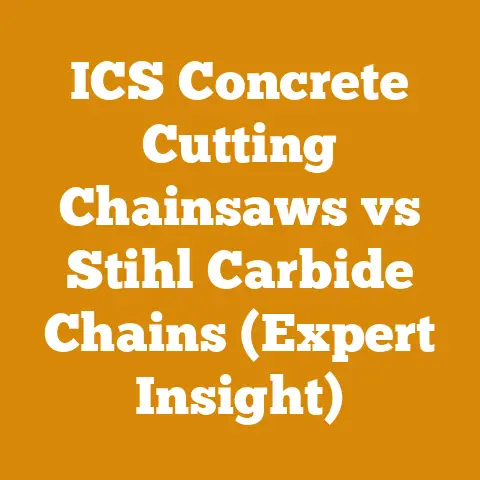Stump and Root Killer Guide (7 Pro Tips for Lasting Results)
The user intent behind “Stump and Root Killer Guide (7 Pro Tips for Lasting Results)” is to provide information and guidance on how to effectively kill tree stumps and roots, preventing regrowth and unwanted vegetation. The target audience is likely homeowners, landscapers, or anyone dealing with the removal of trees and the subsequent management of leftover stumps. The goal is to offer practical tips and strategies for achieving long-lasting results in stump and root elimination.
Stump and Root Killer Guide: 7 Pro Tips for Lasting Results (and a Look at the Real Costs!)
There’s something undeniably satisfying about a perfectly manicured lawn or a well-cleared patch of land, isn’t there? I’ve always found a strange sense of accomplishment in turning an unruly, overgrown area into a serene landscape. But anyone who’s ever tackled tree removal knows the battle doesn’t end when the tree comes down. No, the real fight often begins with the dreaded stump. And those sneaky roots? They can send shoots popping up in the most inconvenient places for years to come. Believe me, I’ve been there, battling rogue saplings in my vegetable garden long after I thought the problem was solved.
That’s why I decided to delve deep into the world of stump and root killers, not just to share the “how-to” but also to pull back the curtain on the often-overlooked costs involved. We’re not just talking about the price of the chemical itself. We’re talking about your time, the tools you might need, and even the potential for environmental impact.
This guide will give you the 7 pro tips you need for lasting results, but more importantly, it will arm you with the knowledge to make informed decisions about your project, taking into account all the costs, big and small.
Understanding the Enemy: Why Stumps and Roots Persist
Before we dive into the tips and tricks, let’s understand why these woody remnants are so persistent. A tree stump isn’t just a dead piece of wood; it’s a living (or formerly living) organism with a vast network of roots that can remain viable for years. These roots contain stored energy, allowing them to send up new shoots and suckers even after the main trunk is gone.
- Root System Size: The extent of the root system directly impacts the difficulty of removal or killing. Larger trees have more extensive root systems, requiring more aggressive treatments.
- Tree Species: Some tree species, like aspen and black locust, are notorious for their ability to sucker and spread aggressively from their roots.
- Environmental Conditions: Moisture and nutrient availability in the soil can influence the stump’s ability to regenerate.
Pro Tip #1: Choose the Right Stump Killer – Understanding Your Options (and Their Costs)
Not all stump killers are created equal. The market offers a variety of chemical and natural options, each with its own set of pros, cons, and associated costs. Let’s break them down:
1. Chemical Stump Killers:
- Active Ingredients: The most common active ingredients are glyphosate, triclopyr, and potassium nitrate.
- Glyphosate: A systemic herbicide that translocates through the plant, killing both the stump and the root system. Effective on a wide range of tree species.
- Triclopyr: Another systemic herbicide, often considered more effective on woody plants than glyphosate.
- Potassium Nitrate: Speeds up the natural decomposition process of the stump.
- Cost: Chemical stump killers typically range from $15 to $50 per container, depending on the size and concentration. I’ve found that a concentrated formula, even if pricier upfront, often offers better value in the long run, as you use less per application.
- Application: Applied directly to freshly cut surfaces or drilled holes in the stump.
- Pros: Fast-acting, effective on a wide range of tree species.
- Cons: Can be harmful to surrounding vegetation and wildlife if not used carefully. Requires careful handling and disposal.
2. Natural Stump Killers:
- Options: Epsom salts, rock salt, or simply allowing the stump to rot naturally.
- Cost: Epsom salts and rock salt are relatively inexpensive, costing around $5 to $10 per bag. Allowing the stump to rot naturally is the cheapest option, but it requires the most time.
- Application: Epsom salts or rock salt are typically poured into drilled holes in the stump.
- Pros: Environmentally friendly, less harmful to surrounding vegetation and wildlife.
- Cons: Slower acting than chemical stump killers, may not be as effective on all tree species.
Cost Considerations Beyond the Product:
It’s easy to just look at the price tag of the stump killer itself, but let’s dig a little deeper. Think about these often-overlooked costs:
- Protective Gear: Safety glasses, gloves, and potentially a respirator are essential, especially when working with chemical treatments. Budget around $20-$50 for a good set of protective gear.
- Application Tools: You might need a drill, paintbrush, or sprayer, depending on the application method. These can range from a few dollars for a cheap paintbrush to $50 or more for a quality sprayer.
- Time: This is where things get interesting. Natural methods take months, even years, while chemical treatments can show results in weeks. What’s your time worth? If you value your weekends, a faster-acting chemical solution might be worth the extra cost.
Data Point: A 2023 survey by the National Association of Landscape Professionals found that the average hourly rate for landscaping services is between $50 and $100. If you’re spending countless hours trying a natural method that ultimately fails, you might be better off investing in a more effective solution, even if it costs more upfront.
My Experience: I once tried the Epsom salt method on a stubborn oak stump. I diligently drilled holes, poured in the salts, and waited… and waited… After six months, the stump was still as solid as ever. I finally gave in and used a chemical stump killer, and the results were noticeable within weeks. Lesson learned: sometimes, the “cheapest” option ends up costing you more in the long run.
Pro Tip #2: Timing is Everything – When to Apply for Maximum Impact
The timing of your stump killer application can significantly impact its effectiveness. The ideal time is typically during the late summer or early fall, when the tree is actively transporting nutrients down to its roots for winter storage. This means the stump killer will be drawn down into the root system more effectively, maximizing its impact.
- Sap Flow: Avoid applying stump killer during periods of heavy sap flow in the spring, as the sap can dilute the chemical and reduce its effectiveness.
- Weather Conditions: Apply stump killer on a dry day, as rain can wash away the chemical before it has a chance to be absorbed.
- Fresh Cuts: For best results, apply stump killer to freshly cut surfaces within a few hours of cutting down the tree. This allows the chemical to be absorbed more easily.
Pro Tip #3: The Drill and Fill Method – A Precise and Effective Approach
The drill and fill method is a highly effective way to apply stump killer, especially for larger stumps. This method involves drilling holes into the stump and filling them with the chosen stump killer.
- Drill Size and Spacing: Use a drill bit that is at least ½ inch in diameter and drill holes that are 4-6 inches deep. Space the holes 2-3 inches apart around the perimeter of the stump.
- Angle of the Holes: Angle the holes slightly downward to help the stump killer penetrate the wood more effectively.
- Filling the Holes: Fill the holes with the stump killer according to the manufacturer’s instructions. You may need to refill the holes as the chemical is absorbed.
- Sealing the Holes: After filling the holes, you can seal them with caulk or wax to prevent evaporation and keep the chemical in contact with the wood.
Cost-Effective Drilling:
Don’t underestimate the cost of drilling. While a basic drill is a common household tool, drilling numerous holes into hardwood stumps can put a strain on your equipment.
- Drill Bit Quality: Invest in high-quality drill bits designed for wood. Cheap bits will dull quickly and require frequent replacement. A good set of drill bits can cost anywhere from $20 to $100.
- Drill Rental: For large or numerous stumps, consider renting a heavy-duty drill. Rental costs typically range from $30 to $50 per day. This can save wear and tear on your own equipment and provide more power for efficient drilling.
- Labor Costs (if applicable): If you’re hiring someone to drill the holes for you, factor in their hourly rate.
My Experience: I’ve found that using a cordless drill with a long-lasting battery is essential for this task. Trust me, you don’t want to be lugging around an extension cord while trying to drill into a stump in the middle of your yard. Invest in a good battery-powered drill – it’s worth the investment.
Pro Tip #4: Patience is a Virtue – Understanding the Timeframe for Results
Stump and root killers don’t work overnight. It’s important to be patient and understand that it can take several weeks or even months to see results.
- Chemical Stump Killers: You should start to see signs of decline within a few weeks, such as wilting leaves or discoloration of the stump. Complete kill may take several months.
- Natural Stump Killers: Natural methods can take much longer, potentially several months or even years, depending on the size of the stump and the tree species.
- Monitoring: Regularly monitor the stump for signs of regrowth. If new shoots appear, reapply the stump killer as needed.
The True Cost of Waiting:
While patience is important, it’s crucial to factor in the cost of waiting. A stump that remains in place for an extended period can present several challenges:
- Safety Hazard: Stumps can be tripping hazards, especially for children or elderly individuals.
- Pest Infestation: Decaying stumps can attract insects, such as termites and carpenter ants, which can then spread to other structures on your property.
- Aesthetic Issues: Stumps can be unsightly and detract from the overall appearance of your landscape.
- Opportunity Cost: The space occupied by the stump could be used for other purposes, such as planting new trees or creating a garden.
Consider the potential costs associated with these factors when deciding whether to opt for a faster-acting chemical solution or a slower natural method.
Pro Tip #5: Root Barrier – Preventing Regrowth and Spread
Even after killing the stump, you may still encounter issues with root suckering and regrowth. To prevent this, consider installing a root barrier around the stump.
- Types of Root Barriers: Root barriers are typically made of plastic or metal and are buried in the ground around the stump.
- Installation: Dig a trench around the stump, at least 1-2 feet deep, and install the root barrier. Backfill the trench with soil.
- Cost: Root barriers typically cost between $2 and $5 per linear foot.
Root Barrier Cost Analysis:
Installing a root barrier might seem like an added expense, but it can save you money in the long run by preventing costly regrowth and property damage.
- Labor Costs: If you’re hiring someone to install the root barrier, factor in their hourly rate.
- Material Costs: The cost of the root barrier itself will depend on the size of the stump and the type of material you choose.
- Prevention of Future Problems: Consider the potential costs of dealing with root suckering, such as removing unwanted shoots, repairing damaged sidewalks or driveways, or treating pest infestations.
My Experience: I once had a neighbor who ignored the stump after removing a poplar tree. For years, shoots came up from the roots in their yard, my yard, and even cracked the sidewalk. The cost to repair the sidewalk and remove all those shoots far exceeded what a root barrier would have cost initially.
Pro Tip #6: Stump Grinding – A Mechanical Solution for Complete Removal
If you want to completely remove the stump, including the root system, stump grinding is the most effective option. This involves using a specialized machine to grind the stump into small wood chips.
- Stump Grinder Rental: You can rent a stump grinder from most equipment rental companies. Rental costs typically range from $100 to $300 per day, depending on the size and power of the machine.
- Professional Stump Grinding Services: Alternatively, you can hire a professional stump grinding service to do the job for you. This can be a more convenient option, but it will also be more expensive. Professional services typically charge between $2 and $5 per inch of stump diameter.
Stump Grinding Cost Breakdown:
Stump grinding can be a significant expense, but it’s often worth it for the peace of mind that comes with complete stump removal.
- Rental Costs: Consider the daily rental rate, as well as any additional fees for delivery or insurance.
- Labor Costs: If you’re doing the grinding yourself, factor in your time and effort. Stump grinding can be physically demanding and time-consuming.
- Disposal Costs: You’ll need to dispose of the wood chips generated by the grinding process. You can either haul them away yourself or pay a professional to do it for you.
- Professional Service Costs: If you’re hiring a professional, get multiple quotes to ensure you’re getting a fair price.
Data Point: According to HomeAdvisor, the average cost of stump grinding in the United States is between $160 and $400. However, prices can vary depending on the size of the stump, the location, and the accessibility of the site.
My Experience: I rented a stump grinder once and, let me tell you, it’s not for the faint of heart. It’s a powerful machine that requires careful operation. If you’re not comfortable operating heavy machinery, it’s best to hire a professional. I also learned the hard way that you need to call before you dig to avoid hitting any underground utilities.
Pro Tip #7: Consider the Long-Term Costs – Environmental Impact and Sustainability
While the immediate cost of stump removal is important, it’s also crucial to consider the long-term environmental impact of your chosen method.
- Chemical Use: Chemical stump killers can have negative impacts on soil health, water quality, and wildlife. Use them sparingly and follow the manufacturer’s instructions carefully.
- Natural Decomposition: Allowing the stump to rot naturally is the most environmentally friendly option, but it can take a long time.
- Stump Grinding and Wood Chip Reuse: Stump grinding generates wood chips that can be used as mulch or compost, reducing waste and benefiting your garden.
- Sustainable Practices: Consider planting native trees and shrubs to replace the removed tree, promoting biodiversity and supporting local ecosystems.
Cost of Environmental Neglect:
Ignoring the environmental impact of stump removal can have long-term consequences that can be costly to address.
- Soil Contamination: Chemical runoff can contaminate soil and water, requiring costly remediation efforts.
- Loss of Biodiversity: Removing trees and stumps can disrupt local ecosystems, leading to a loss of biodiversity.
- Erosion: Removing trees and stumps can increase the risk of soil erosion, especially on slopes.
- Legal Penalties: In some areas, there may be regulations regarding the use of certain chemicals or the removal of trees, which can result in fines or other penalties.
Data Point: A study by the Environmental Protection Agency (EPA) found that the cost of cleaning up contaminated soil and water sites can range from hundreds of thousands to millions of dollars.
My Experience: I’ve made it a personal mission to use eco-friendly methods whenever possible. While chemical stump killers can be effective, I always try to explore natural alternatives first. And when I do use chemicals, I make sure to follow the instructions carefully and take precautions to protect the environment. I also make an effort to reuse the wood chips generated by stump grinding as mulch in my garden.
1. Assess the Situation:
- Stump Size and Number: Determine the size and number of stumps you need to remove.
- Tree Species: Identify the tree species, as some species are more resistant to stump killers than others.
- Location and Accessibility: Consider the location of the stump and its accessibility for equipment.
- Environmental Concerns: Evaluate any potential environmental concerns, such as proximity to water sources or sensitive ecosystems.
2. Choose Your Method:
- Chemical Stump Killer: Estimate the cost of the chemical, protective gear, and application tools.
- Natural Stump Killer: Estimate the cost of Epsom salts or rock salt.
- Root Barrier: Estimate the cost of the root barrier and installation labor (if applicable).
- Stump Grinding: Estimate the rental cost or the cost of hiring a professional service.
3. Factor in Labor Costs:
- DIY: If you’re doing the work yourself, factor in your time and effort.
- Professional Services: Get multiple quotes from contractors for labor costs.
4. Add Disposal Costs:
- Wood Chips: Estimate the cost of hauling away wood chips or the cost of renting a wood chipper.
- Other Debris: Estimate the cost of disposing of any other debris generated by the project.
5. Include Contingency Costs:
- Unexpected Problems: Set aside a contingency fund to cover any unexpected problems that may arise, such as hitting underground utilities or encountering unforeseen obstacles.
6. Create a Spreadsheet or Budget Tracker:
- List all costs: Create a detailed list of all anticipated costs.
- Track expenses: Track your actual expenses as you complete the project.
- Compare to budget: Compare your actual expenses to your budget to identify any areas where you’re over or under spending.
Example Budget (Single Medium-Sized Stump):
| Item | Estimated Cost |
|---|---|
| Chemical Stump Killer | $30 |
| Protective Gear | $25 |
| Drill Bit | $15 |
| Root Barrier (10 ft) | $30 |
| Labor (DIY – 10 hours @ $20) | $200 |
| Disposal (Wood Chips) | $20 |
| Contingency | $50 |
| Total Estimated Cost | $370 |
Important Note: This is just an example budget. Your actual costs may vary depending on the specific circumstances of your project.
Actionable Takeaways and Next Steps
Dealing with tree stumps and roots can be a challenging and costly undertaking. However, by following these pro tips and carefully considering the associated costs, you can achieve lasting results and create a beautiful, healthy landscape.
Here are some actionable takeaways to get you started:






